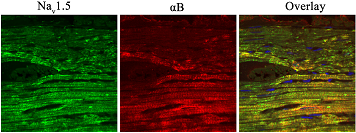Overview
- GST fusion protein with amino acid residues 1978-2016 of human NaV1.5 (Accession Q14524), (MW: 33 kDa.). Intracellular, C-terminus.
- NaV1.5 transfected HEK-293 cells (1:200).
 Western blot analysis of NaV1.5 in NaV1.5 transfected HEK-293 cells:1. Anti-NaV1.5 (SCN5A) (1978-2016) Antibody (#ASC-013), (1:200).
Western blot analysis of NaV1.5 in NaV1.5 transfected HEK-293 cells:1. Anti-NaV1.5 (SCN5A) (1978-2016) Antibody (#ASC-013), (1:200).
2. Anti-NaV1.5 (SCN5A) (1978-2016) Antibody, preincubated with Nav1.5/SCN5A (1978-2016) Blocking Peptide (#BLP-SC013).
- Rat myocardium paraffin embedded section (1:100).
- Human atrial myofibroblasts (1:200) (Chatelier, A. et al. (2012) J. Physiol. 590, 4307.).
- THP-1 human premyelomonocytic leukemic cells (Carrithers, M.D. et al. (2007) J. Immunol. 178, 7822.).
- The control antigen is not suitable for this application.
Voltage-gated Na+ channels (NaV) are responsible for myocardial conduction and maintenance of the cardiac rhythm and are essential for the generation of action potentials and cell excitability.1
Dysfunction or disregulation of cardiac sodium channels can cause several disorders, including cardiac arrhythmias.
The majority of Na+ channels in the mammalian heart are Tetrodotoxin (TTX) insensitive NaV1.5.2
The putative structure of NaV1.5 consists of four homologous domain (I-IV), each containing six transmembrane segments (S1-S6). Mutations in the C-terminus of NaV1.5 were described in connection to Long QT syndrome and Brugada syndrome.1-2 Recent data have demonstrated selective expression of NaV1.5 in the mouse central nervous system and implicated a role for NaV1.5 in the physiology of the central nervous system.1
Application key:
Species reactivity key:

Expression of NaV1.5 in rat heart.Immunohistochemical staining of rat heart sections using Anti-NaV1.5 (SCN5A) (1978-2016) Antibody (#ASC-013). NaV1.5 staining (green), (left panel). αB-Crystallin staining (red), (middle panel). Merged image (right panel) demonstrates that the two proteins co-localize in rat heart.Adapted from Huang, Y. et al. (2016) J. Biol. Chem. 291, 11030. With permission of The American Society for Biochemistry and Molecular Biology.
